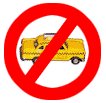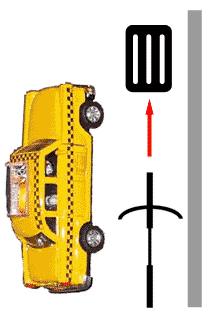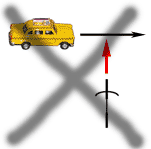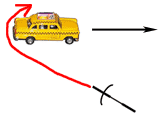
Street Techniques
Unweighting the Wheels
Upping a Curb
Getting Down a Curb
Hopping a Sewer Grate
The Bike Messenger's Hook
NOTE: The techniques below are described in terms of a fixed-gear bike with toe-clips or clipless pedals. There are similar techniques, such as the bunnyhop and the endo, for flat-pedaled MTBs or trials bikes. Check out "How to Bunnyhop Like Jeff Lenosky," by Jeff Lenosky and Jason Schwinabart, DIRT RAG #98, pp. 88-89. For online instruction in trials moves for MTB/trials bikes, see Biketrials.com's How-To Manual.There are several techniques that all fix riders would do well to have in their bag of tricks. Getting over small obstacles such as pot-holes, sewer grates and small curbs will save your hubs, spokes and tires. The key to getting over obstacles is unweighting your wheels. Unweighting your wheels also helps in skip-stopping and skidding, which are covered in my Fixed-Gear 101).
Safety note: Before proceeding, make sure you have read the safety measures in
How not to get hit by cars.
Unweighting the Wheels
To unweight the wheels, it's helpful to separate the motions for unweighting the front from the
motions for the rear. Unweighting the front wheel is like the move in a wheelie. Unweighting the rear wheel brings your weight up and to the front of the bike with your hips in the air. In both cases, it helps to practice with your pedals in your dominant 3 o'clock - 9 o'clock position. If you do a wheelie, which foot likes to be forward? Perhaps your stronger leg prefers to be forward, for the extra push on the pedal. Find this position for your body and use it while learning. In real life of course, your pedals won't be in this convenient position when you enounter an obstacle. But once you get the feel of things at 3 and 9, it will be easier in the other pedal positions.
Front wheel. To bring the front wheel off the ground, lift your butt off the saddle and shift your hips up and back. Push downward with the forward foot, and pull up and back on the handlebars. Start out trying for just a quarter of an inch, concentrating on letting the tire down gently as well. (This is done by pulling gently up as the wheel reaches the ground again.) At first, try to find a playground, trying only to clear the white line of a basketball court. Then try for the lip of a driveway. Don't try anything higher until you can unweight the rear wheel as well. Your rear hub and spokes will appreciate it.
Rear wheel. To unweight the rear wheel, these things happen in maybe less than a second,
in this order:
- Your pedals approach the dominant 3-9 position (in real life it's a luxury, but take advantage now).
- As you get close to lift-off, compress your body onto the bike.
- Now! Spring up and forward from the pedals, off the saddle, putting lots of body weight on the handlebars.
- Suck up with your legs and pull up with your toes, lifting the rear wheel, pushing forward with the handlebars, remembering that the pedals are still rotating.
- Think air, space, lightness.
- Let the rear wheel gently make contact with the ground now on this higher surface, without your body weight.
- Let the pedals take your body weight again.
- Sit back on the saddle and continue rolling.
When you become more proficient with this, you can feather your rear wheel. That is,
finesse step (7) above by pulling up again with your toes just before the rear
wheel contacts the ground. (This is like how people imagine that falling-elevator emergency -
in their minds, they'll jump up from the elevator car right as it hits the ground!)
Again, feathering is good for your bike. I have those dodgy high-flange Campy track
hubs, but with this feathering technique I've gotten away with these moves for years,
even going up high curbs and down small staircases....
Upping a Curb
Sometimes you need to get up a curb. Maybe it's the quickest way to that deli on the block, or to
the railing where you can lock your bike. But you don't want to dismount and lift the bike.
And you don't want the wheels to slam into the curb. You can approach the curb straight on,
or at an oblique angle. Try to keep the angle of approach between 45 and 90 degrees - lesser
angles can make you slide out. You can play with the angle and your available distance from
the curb to help set up your ideal wheelie pedal position of 1:30-7:30. A vertical pedal angle of 6-12
is do-able, but difficult.
Start practicing on the 1- or 2-inch lip of a driveway, then move on to smaller and larger curbs.
Upping these things is not a jump or a hop. One wheel always stays on the ground. You just bring the
front wheel up, then set it down on the higher surface. Then the rear wheel.
In close-up:
- Ride toward the obstacle. Start with a driveway lip. In learning mode, set up for the
3-9 pedal position (well, more like 1:30-7:30). Do it like this. Roll your bike up to the lip.
Arrange the bike so that the dominant wheelie pedal is forward while the front tire is touching the lip.
How far forward should the pedal be? Try placing it halfway between vertical and flat forward, about
45 degrees or a bit above. Now roll the bike backwards about 3 bike lengths away from the obstacle.
Note the position of the pedals. If you start in this position at this distance, your pedals will be
in the advantageous position when you get to back to the lip. Of course in real life, when you get to
the obstacle, your pedals will be in every position other than this one. About one bike-length away, lift
your butt off the saddle and shift your hips about 6 inches to the rear.
- Unweight the front wheel and get it up the obstacle. Say the obstacle is
2 inches high. Then, with the front wheel about 2-3 inches back from the obstacle, push down
with the forward foot, lift up with the handlebars and lean back. Try to lift the wheel just
enough to get it over and gently on top of the obstacle. Keep rolling, and shift your weight
forwards, letting the handlebars take more weight. You're ready for the rear wheel to
approach the obstacle.
- Unweight the rear wheel and get it up the obstacle. You're still
rolling forward, and your pedals are no longer in the most advantageous position. As
your rear wheel is about one height-length away from the obstacle, do the following
in a snap: (i) Shift your weight further towards the handlebars. (ii) Suck your legs
up and forwards, pulling up with your toes on the pedals. (iii) Push forward with the
handlebars. (iv) Visualize levering the back wheel up with the front wheel as a pivot,
thinking "Up, Forward, Light, Smooth." (v) Let the back wheel back down to the surface.
(vi) Let the pedals take your body weight. (vii) Sit back on the saddle.
The forward-pushing motion with the handlebars is easier with bullhorns than with track drops, but it's do-able either way. Try to go for the smallest and smoothest motion required to clear that amount of height. The back wheel might gently bump the corner of the obstacle on the way up, which is OK. But it shouldn't whack straight into it. You're up! - Ride toward the curb, at 45-90 degrees. Pedal position - again, try to go for your optimal
wheelie position, somewhat before the pedals get to the flat 3 and 9. I like the pedals to reach 3-9 when the front
wheel is down and the rear wheel is up.
- Butt off the saddle, lean back, pedals in position, gently lower the front wheel down.
- Right before the front wheel touches, unweight it. This is the same movement you do in upping the front wheel - you spring up and back from the pedals, your
weight is back, and you pull up and back on the handlebars.
- The front wheel lands without your body weight. The front wheel is now on the ground, the
rear is still on the curb.
- Shift your weight forward while rolling the rear wheel towards the curb. Lean over the
handlebars, using the front wheel as a pivot.
- As the rear wheel goes over the lip, push backwards on the pedals. With the aid of the tire gripping on the
curb lip, the back-pedal pressure will slow the descent. At some point, you will feel the rear wheel let loose and fall.
- While the wheel is in the air, unweight and pull up. This again is the same movement you used in upping the rear wheel. The idea is that you feather the wheel to the ground by pulling up to lighten the wheel's descent.
- Speed up as you approach the obstacle.
- At a couple of bike-lengths away, compress your body over the bike, shifting your weight down, but not forward.
- At a wheel-diameter away, spring up and forwards from the saddle. Think that you are long-jumping up over the obstacle.
- Pull up and forwards on the handlebars in a forward arc, but don't angle the handlebars down.
- Pull up and forwards on the pedals - no matter where they are in their rotation. You can't of
course expect them to be positioned anywhere convenient!
- Hang. Think Air.
- Land flat or rear wheel slightly sooner. Try to let the bike land with its own weight while you are still in the air.
- After both wheels are on the ground, re-weight the pedals.
- Sit back in the saddle.
OK, you've got your Snapple and unlocked your bike. You could roll it and gently lower it into the street
with a cool over-the-front mount. But you can also ride down the curb. The trick is to land the wheels on the
ground one at a time, without your body weight. As for the stress on the bike,
this is about equivalent to the bike going down the curb without
a rider. Actually, if you feather the wheels right before impact with the unweighting techniques discussed above,
you can make the impact even lighter than the bike weight itself.
Here are the steps you can use. You can begin practice descending a driveway, then go on to low curbs:
You're there!
Hopping a Sewer Grate

You're riding along next to the curb, traffic whooshing by. Suddenly you see a sewer grate up ahead. You're in traffic. You can't swerve around it. You're boxed in, going fast, committed in this forward direction. Hop over it!
Sewer grates can catch a wheel and throw you off the bike. And you can't always ride
around them, because that will take you into traffic. So hopping them is the best thing.
Most wheel-eating grates are shorter than 27", but if your weight is on the saddle,
even a 4"-grate acts like a bottomless pot-hole. In terms of distance covered, the
maximum you'll have to clear is the wheelbase of the bike plus the length of the grate.
The faster you are going, the better. And of course there are distractions - traffic
on one side, and a curb on the other.
So how do you do it? It's more like a hop or a lunge than an up, since you have to get both wheels
off the ground at once. But it's adapted for distance over a flat surface, in narrow road
conditions and traffic. You'll be going for speed and a bit of distance, not height for its
own sake. You don't want your bike off the ground any longer than required to keep from
catching a wheel.
The best way to begin is to find a piece of cardboard or noisy sheet metal about a 12" x 12" and take it
back to the playground where you practiced unweighting your wheels. This will be your practice sewer grate.
You'll definitely hear it if you land on this. The movements happen very quickly, almost at once.
Basically, it all takes advantage of the unweighting you have done up to this point, but it's
a different move. It's more like lunging yourself up and forward, pulling the bike up and after you.
The wheels lift off almost together, maybe the front wheel a fraction of a second earlier. And the wheels
touch down almost together, maybe the rear wheel a bit earlier. The steps, in slow motion, are these:
While in the air, try to keep the bike from leaning and the front wheel from jerking to one side or the other. This jerking
can come from when you sprang out of the saddle and pulled upwards while the pedals were in a random funky
position. Remember, when you're on the street with this, there will probably be traffic.
The Bike Messenger's Hook

When crossing a street or intersection with side traffic, the normal way to do it is this. You slow down, stop, wait for the car to go by. You can do it that way, but it takes longer and forces you to slow a lot or even stop. That's not so convenient if you can't trackstand and you're clipless or your toe-straps are down tight. Who wants to put a foot on the ground?
So cross the street the way the bike messengers do it. Rush at the car and hook around the back.
This is especially effective when you cross one-way streets. I use the messenger's hook all the time,
even when I'm on foot walking through stalled traffic.

You do it like this. Check around both sides and in back of you. Check the side traffic. You see the car coming from your left to your right. There's no car immediately behind it. And the lane you're occupying is clear. So you go for it. You ride at an oblique angle towards the car. You're both moving. As the car passes, you hook around its back bumper and continue on your way. You will be the first one across the street.
It looks and sounds suicidal, but it's quite safe. The driver probably won't see you. But if they
do, they won't worry because you aren't getting in front of them. They'll probably know you are
planning on going around the back.
© Greg Goode, 2003